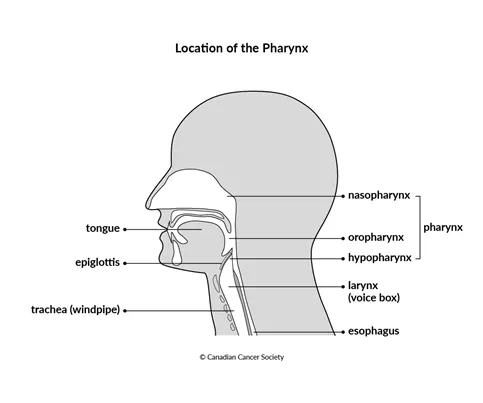Stages of oropharyngeal cancer
Staging describes or classifies a cancer based on how much cancer there is in the body and where it is when first diagnosed. This is often called the extent of cancer. Information from tests is used to find out the size of the tumour, which parts of the organ have cancer, whether the cancer has spread from where it first started and where the cancer has spread. Your healthcare team uses the stage to plan treatment and estimate the outcome (your prognosis).
The most common staging system for oropharyngeal cancer is the TNM system. For oropharyngeal cancer there are 5 stages – stage 0 followed by stages 1 to 4. Often the stages 1 to 4 are written as the Roman numerals I, II, III and IV. Generally, the higher the stage number, the larger the cancer is or the more the cancer has spread. Talk to your doctor if you have questions about staging.

When describing the stage, doctors may use the words local, regional or distant. Local means that the cancer is only in the oropharynx (the middle part of the pharynx) and has not spread to other parts of the body. Regional means the cancer has spread to the lymph nodes in the neck (cervical lymph nodes). Distant means in a part of the body farther from the oropharynx.
Find out more about staging cancer.
Stage 0 (carcinoma in situ)
The tumour is only in the lining of the oropharynx.
Stage 1
The tumour is 2 cm or smaller.
Stage 2
The tumour is larger than 2 cm but not larger than 4 cm.
Stage 3
The tumour is larger than 4 cm or has grown to the epiglottis (a flap of moveable cartilage in the throat that closes the larynx when you swallow).
OR
The cancer has spread to 1 lymph node in the neck on the same side as the tumour. The lymph node is not larger than 3 cm.
Stage 4
Stage 4 oropharyngeal cancer can be divided into stages 4A, 4B or 4C depending on:
-
which nearby areas the tumour has grown into, such as the larynx, muscles of the tongue, lower jawbone or skull
-
the number and size of the lymph nodes with cancer
-
if the cancer has grown outside of lymph nodes (extranodal extension)
-
whether the affected lymph nodes are on the same or opposite side of the neck as the tumour, or on both sides of the neck
-
if the cancer has spread to other parts of the body farther from the pharynx, such as to the lungs or liver (called distant metastasis)
Recurrent oropharyngeal cancer
Recurrent oropharyngeal cancer means that the cancer has come back after it has been treated. If it comes back in the same place that the cancer first started, it’s called local recurrence. If it comes back in tissues or lymph nodes close to where it first started, it’s called regional recurrence. It can also recur in another part of the body. This is called distant metastasis or distant recurrence.
Stage 0
The tumour is only in the lining of the oropharynx.
Stage 1
The tumour is not larger than 4 cm. The cancer may have spread to 1 lymph node in the neck on the same side as the tumour. The lymph node is not larger than 6 cm.
Stage 2
The tumour is not larger than 4 cm and the cancer has spread to 1 or more lymph nodes on the opposite side of the neck as the tumour or to lymph nodes on both sides of the neck. The lymph nodes are not larger than 6 cm.
OR
The tumour is larger than 4 cm or has grown to the epiglottis (a flap of moveable cartilage in the throat that closes the larynx when you swallow). The cancer may have spread to lymph nodes in the neck and they are not larger than 6 cm.
Stage 3
The cancer has spread to 1 or more lymph nodes in the neck that are larger than 6 cm.
OR
The tumour has grown around a carotid artery or has grown into any of the following:
- larynx
- muscles of the tongue
- nearby bones of the skull
- bony part of the roof of the mouth (hard palate)
- lower jawbone (mandible)
- nasopharynx
Stage 4
The cancer has spread to other parts of the body (called distant metastasis), such as to the lungs, the liver or other bones.
Your trusted source for accurate cancer information
With support from readers like you, we can continue to provide the highest quality cancer information for over 100 types of cancer.
We’re here to ensure easy access to accurate cancer information for you and the millions of people who visit this website every year. But we can’t do it alone.
Every donation helps fund reliable cancer information, compassionate support services and the most promising research. Please give today because every contribution counts. Thank you.
